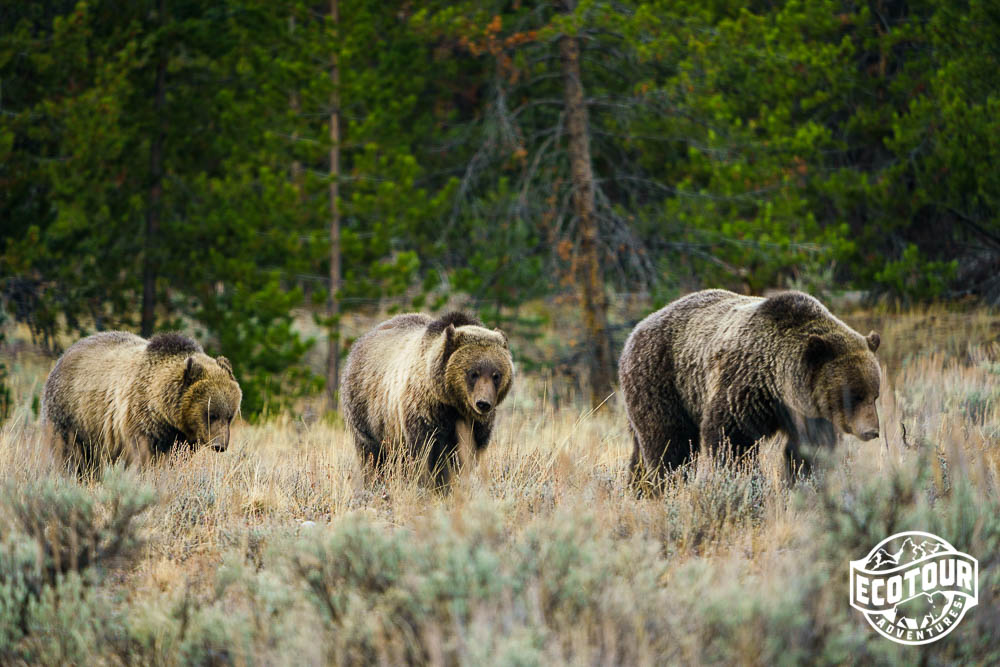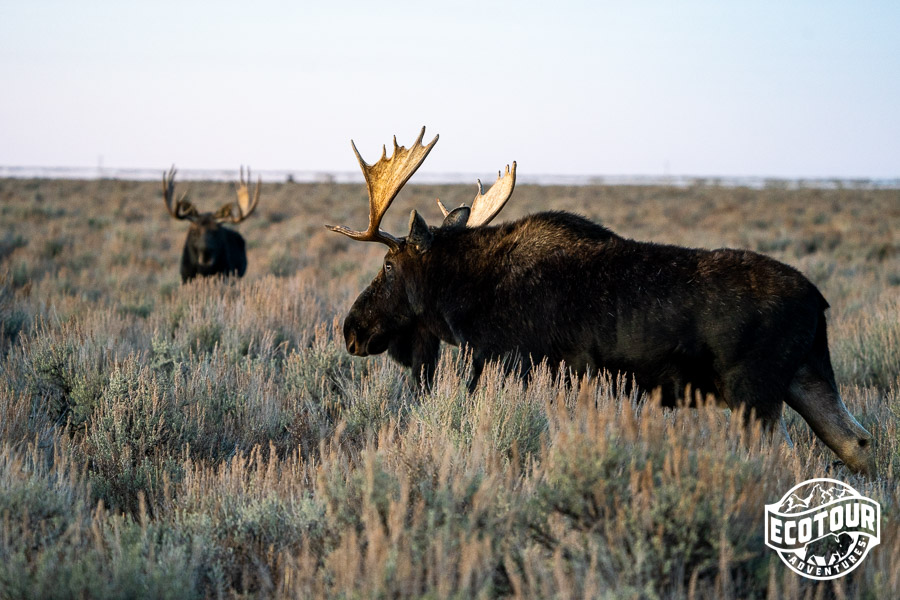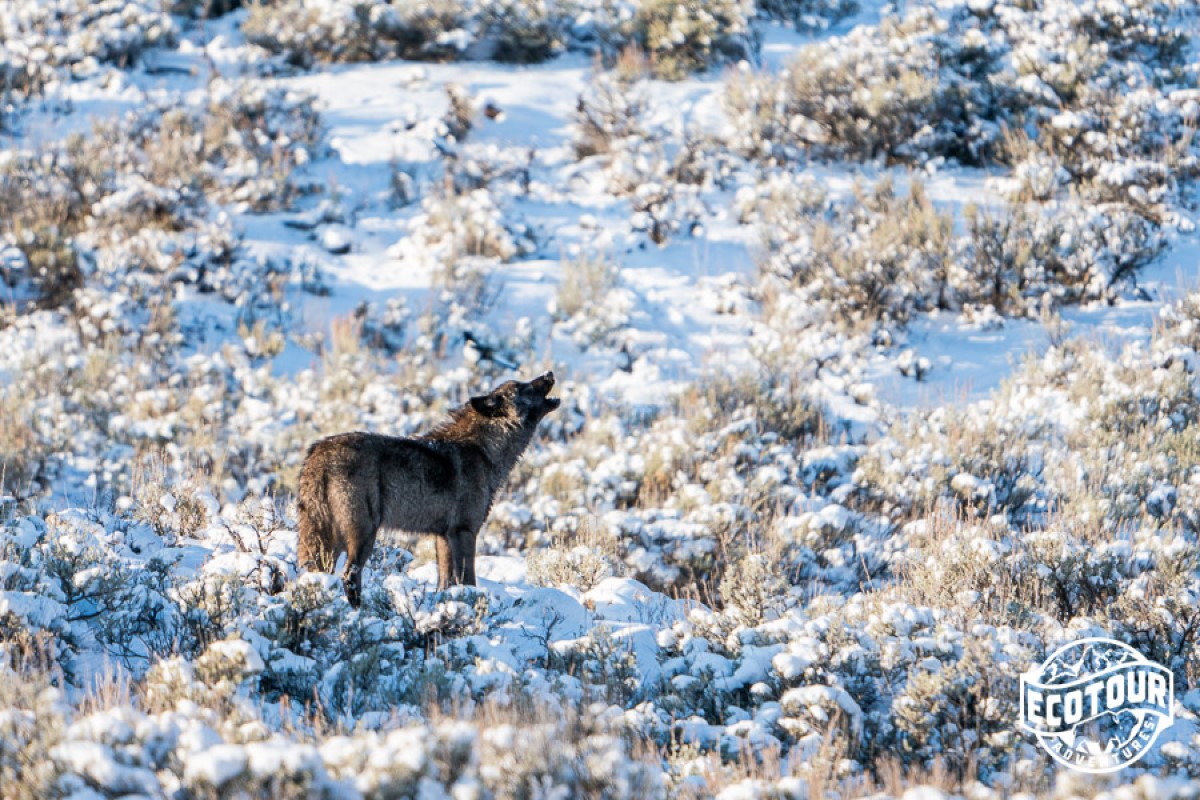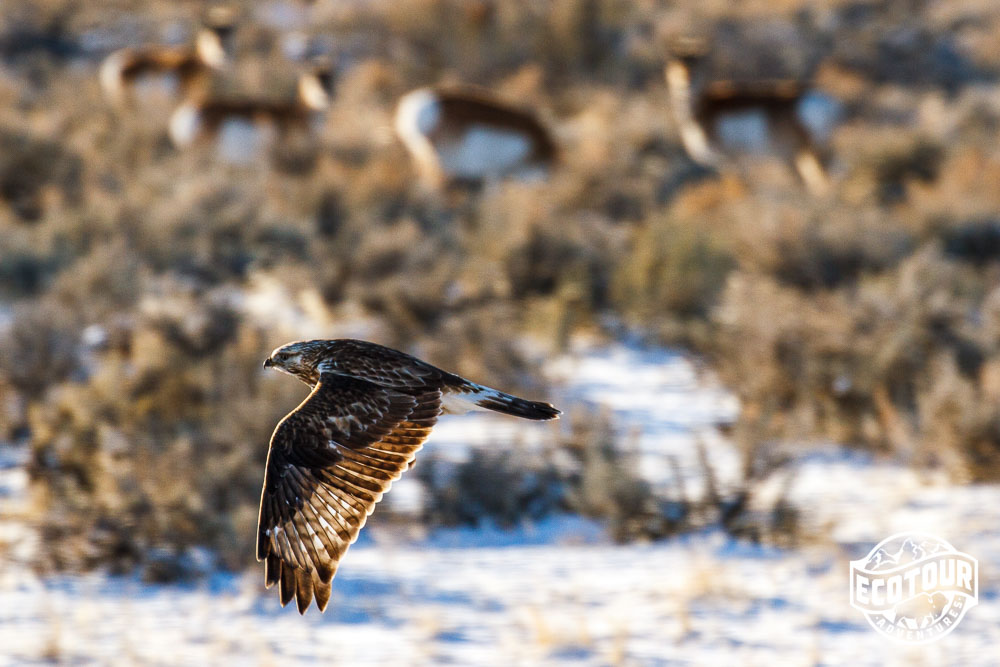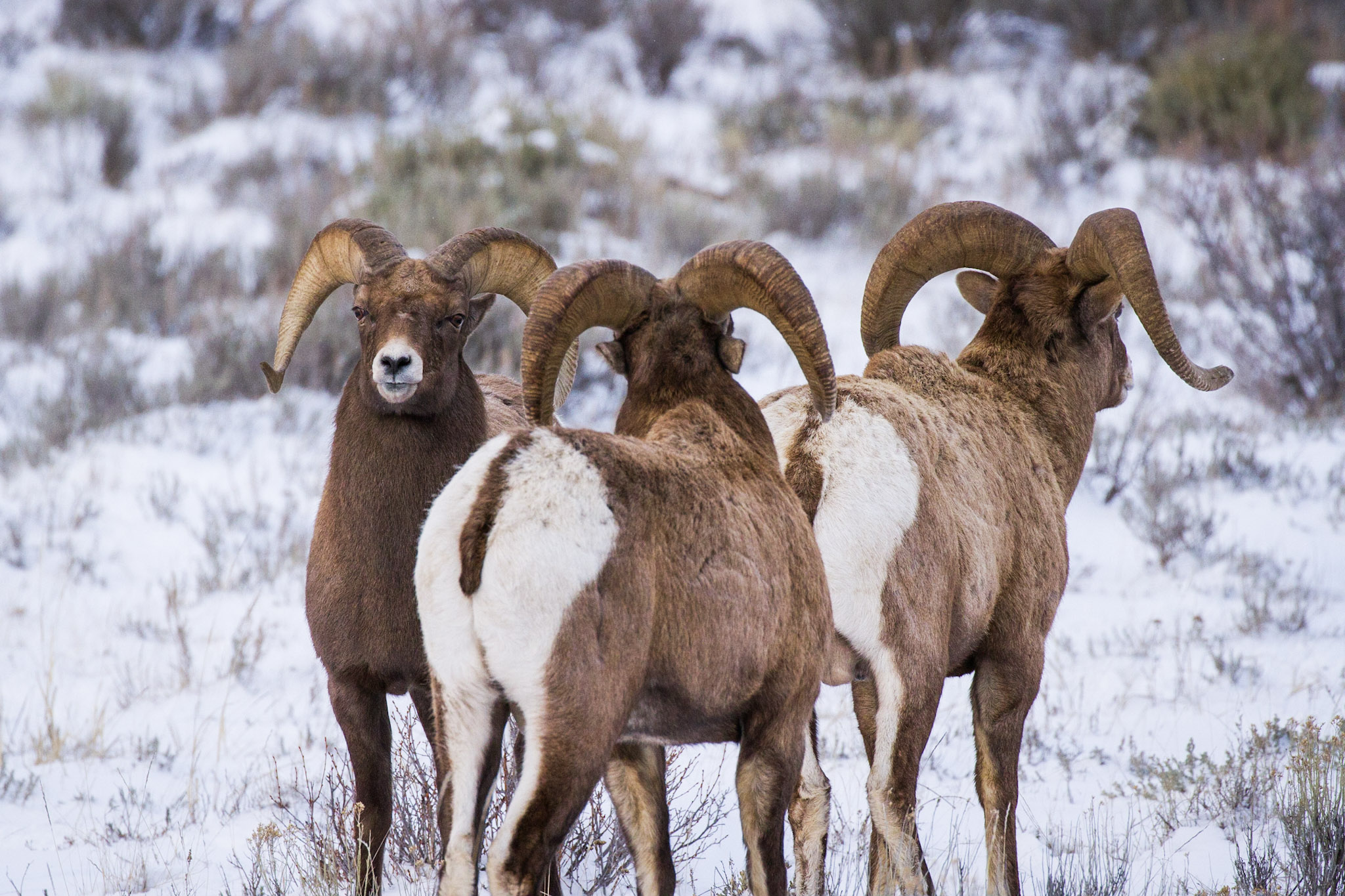Late Fall Wildlife Watching in Jackson Hole
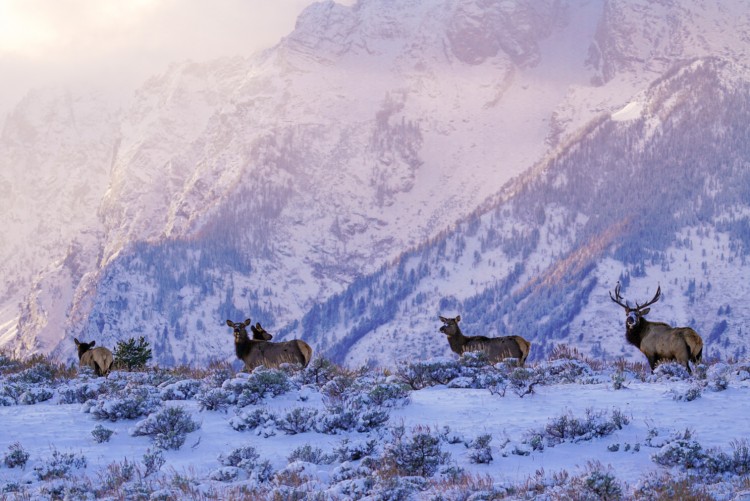
What to see in Grand Teton and the National Elk Refuge in October, November and December
It’s about to get crowded in the Jackson Hole Valley, with animals that is. Thousands of elk, bighorn sheep, mule deer, moose, bison, and pronghorn are beginning to migrate across Grand Teton National Park and the National Refuge, concentrating as they head towards critical winter range. Eagles, Trumpeter swans, and diverse waterfowl species are also joining in to the gathering. Determined wildlife watchers may even spot grizzlies or wolves! With the human crowds of summer long gone, Late October, November, and December are fantastic months to view wildlife of all types, here’s what not to miss!
Grizzly Bears Fattening up before Hibernation
As winter quickly approaches, grizzlies and black bears enter hyperphagia, or excessive eating, in order to ensure they have the fat stores to survive the winter. Though black bears often head into dens by later October, grizzlies are taking advantage of the last of berries, edible vegetation, and carcasses to scavenge before turning in.
For female bears, the more fat they can store, the more prepared their bodies will be to gestate, give birth to, and nurse their cubs in the den throughout the winter months. The health and amount of fat stores a sow, or female bear, has going into hibernation will be one determining factor for the number of cubs to which she gives birth. Expect sightings to start to dwindle in mid to late November depending on food availability.
In many parts of the Greater Yellowstone Ecosystem grizzlies head into dens around late November, but in Jackson Hole we've seen bears active through the end of December in some years! Photo by guide Josh Metten
Moose Concentrate in the Sagebrush Flats of Grand Teton
Other species are busy eating or collecting food sources that will soon be covered by snow, and inaccessible to them, as a result. Moose are shifting from existing mostly in riparian environments, such as river beds, to open areas like the sagebrush flats of Antelope Flats. They are taking advantage of antelope bitterbrush, a shrubby plant which holds onto its leaves longer into the fall and early winter than many of the surrounding vegetation.
Antelope bitterbrush is found amongst the sagebrush flats in the south eastern portion of Grand Teton. In late fall and early winter it is common to find moose in small groups feeding on this fantastic food source. While often a solitary species, moose will tolerate each others’ presence to feed. This offers the unique viewing opportunity of seeing many adult moose together in a relatively small area.
Bull moose often keep their antlers until late December or January. Photo Josh Metten
Red Pine Squirrels and other charismatic Minifauna!
Red squirrels are busy scurrying around the forests of the Greater Yellowstone Ecosystem collecting pine cones for their food caches, or middens that they eat from all winter. These small mammals do not hibernate through winter, so they spend the majority of late summer and fall creating large food stores to feed off of throughout the winter months. Unfortunately for the red squirrel, other species are aware of their work, and their middens are sometimes raided by larger species, such as bears, who can deplete an entire pine nut cache in a matter of minutes.
Squirrels must also be on the look out for predators such as the weasels who remain active all winter long. These athletic carnivores must hunt constantly, relying on their metabolism to keep their sleek athletic bodies warm. In the coming months, weasels, along with snowshoe hares will grow a white coat to replace their brown summer coats, an additional layer of camoflauge to aid their survival in the winter world.
Elk, (and other species!) Migrate to the National Elk Refuge
Viewing opportunities increase for species who migrate through the Jackson Hole valley on their way to wintering grounds, such as elk. As snow accumulates at higher elevations, elk start their migrations to lower elevations. Elk will become visible on the valley floor near the Snake River throughout the month of November, depending on weather patterns. Many are making their way to the National Elk Refuge, where there is less snowfall, and more easily accessible food as a result. These migratory routes have existed for generations upon generations, passed down from cow to calf year after year.
The Refuge and surrounding mountainsides support a diverse assortment of wildlife in winter. On some winters, a small herd of pronghorn antelope will remain in the valley instead of migrating 100 miles south with the rest of the herd. Though mule deer do winter on the refuge they are more often observed above the valley on the slopes of the East Gros Ventre Butte. Hwy 189/191 heading north of town is a dangerous road for these deer, be sure to slow down and watch out for wildlife, especially in the winter months.
Elk venture from as far away as Yellowstone National Park to winter on the National Elk Refuge. Photo by guide Kirk Ryder
Search for Wolves in the Wilds of Jackson Hole
With over 5000 elk wintering on the refuge, it's often a great place to look for coyotes, wolves, and mountain lions. Wolves become much easier to view in the fall and winter months and if you are lucky you may have the opportunity to watch a wolf pack test or even hunt elk. This ancient dance of predator and prey continues today thanks to a successful reintroduction to Yellowstone over a quarter century ago.
Winter is one of the best times of years to see wild wolves in Grand Teton and Yellowstone National Parks. PC: Josh Metten
Eagles, Rough-Legged Hawks, Swans and other winter birds arrive in Jackson Hole
Despite the long, snowy winters, Jackson Hole is considered a mild location to spend the winter for some species. In fall we start to experience increased sightings of species such as bald eagles and rough-legged hawks. Rough-legged hawks and some bald eagles summer farther north in Canada and Alaska, migrating south to the lower 48 for the winter months.
There are bald eagles and trumpeter swans in the Greater Yellowstone Ecosystem year-round, however there is the opportunity to view them more frequently in late fall and winter as their numbers increase with individuals that migrate here from Canada and Alaska. The trumpeter swans floating in Kelly Warm Springs or on Flat Creek on the National Elk Refuge are a beautiful sight to behold.
Rough-legged hawks nest above the arctic circle in summer and are a welcome addition to winter wildlife sightings in Jackson Hole during the winter months. PC: Josh Metten
Experience the Bighorn Sheep Rut on the National Elk Refuge
A local bighorn sheep herd makes a shorter migration into the Jackson Hole valley for the late fall and winter months. Bighorn sheep in the area spend summers at very high elevations in the mountains surrounding Jackson Hole. As snow accumulates and covers their food sources at these elevations, they migrate down to Miller Butte on the National Elk Refuge.
This location is in close proximity to the road and offers excellent viewing opportunities with binoculars or spotting scopes, and at times even with the naked eye. November is an excellent time to see them, as their rut, or mating season, is underway. Rams can be seen dramatically clashing together to compete for mates.
Learn more about the bighorn sheep rut!
Observing the Bighorn sheep mating season right outside of the town of Jackson, WY is one of our favorite annual events. PC: Josh Metten
Respecting Wildlife and Critical Winter Range
It is important to note that the upcoming winter is the hardest time of year for wildlife in the Greater Yellowstone Ecosystem. Over the next few months winter wildlife closures will protect critical habitat for animals that largely rely on their fat reserves to endure the winter months. By allowing wildlife appropriate viewing distances and utilizing binoculars and spotting scopes, they are able to forage stress-free and continue to build much needed fat stores for the winter months.
Learn more about EcoTour Adventures commitment to conservation and the importance of winter wildlife closures here.
Late Fall and Winter Adventure Awaits in Jackson Hole
With so many species active and on the move in the fall and early winter, it is a fantastic time of year to visit and explore the Greater Yellowstone Ecosystem. By late November we’ll be exploring Grand Teton National Park on XC Skis or Snowshoes and on December 15th Sleigh Rides on the National Elk Refuge begin. Be sure to bring your camera to capture all there is to see!
ETA Naturalist Elise Tonelli grew up in Central Pennsylvania, and received a BA in Environmental Studies from the University of Pittsburgh with a concentration in environmental education. Having the ability to spend time outdoors connecting people to nature has always been an aspect of guiding with EcoTour Adventures that she values and enjoys most. In her own time, Elise enjoys getting out to explore this wonderful corner of Wyoming in any way she can.


